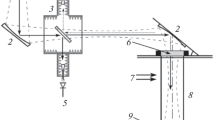The effect of the design features of the gas-discharge tube on the processes proceeding in the discharge circuit of a metal-vapor laser has been investigated. The position of electrodes in the gas-discharge tube has been found to significantly affect the processes at work in the discharge circuit and the energy characteristics of the laser. For instance, gas-discharge tubes with electrodes placed in the hot region of the discharge channel are typified by high metastable-population rates at the leading edge of the excitation pulse, whereas with electrodes positioned in cold buffer regions, the leading edge of the voltage pulse across the resistive component of the tube impedance is seen to peak. Conditions for running-wave generation in the active media of lasers on self-terminated transitions of metal atoms and the running-wave use efficiency for laser pumping are discussed, considering a strontium-vapor laser as an illustration. It is shown that the running wave is generated as the result of the breakdown in the anode end of the gas-discharge tube and is maintained by the energy stored in the capacitive component of the impedance of the gas-discharge tube. The lasing pulse duration under running-wave excitation corresponds to the time it takes an ionization wave to propagate from the anode to the cathode of the gas-discharge tube, with pumping efficiency being ~6–8% for a strontium-vapor laser. The average lasing power varies within 10–15% depending on whether the totally reflecting cavity mirror is placed near the anode or the cathode of the tube.
Similar content being viewed by others
References
G. G. Petrash, Usp. Fiz. Nauk, 105, 645–676 (1971).
A. N. Soldatov and V. I. Solomonov, Gas-Discharge Lasers on Self-Terminated Transitions of Metal Vapors [in Russian], Nauka, Novosibirsk (1985).
V. M. Batenin, V. V. Buchanov, M. A. Kazaryan, et al., Lasers on Self-Terminated Transitions of Metal Atoms [in Russian], Nauchnaya Kniga (1998).
C. E. Little, Metal Vapour Lasers. Physics, Engineering and Application, New York (1999).
A. G. Grigor’yants, M. A. Kazaryan, and N. A. Lyabin, Copper-Vapor Lasers. Design, Characteristics, and Application [in Russian], Fizmatlit, Moscow (2005).
A. N. Soldatov, V. F. Fedorov, and N. A. Yudin, Kvant. Elektron., 21, 733–734 (1994).
N. A. Yudin, V. M. Klimkin, V. E. Prokop’ev, and V. T. Kalaida, Russ. Phys. J., 42, No. 8, 709–713 (1999).
R. J. Carman, D. J. W. Brown, and J. A. Piper, IEEE J. Quantum Electron., 30, 1876–1895 (1994).
A. N. Soldatov, Contemporary Problems of Optics and Spectroscopy, Yu. S. Makushkin, G. V. Mayer, and A. M. Yancharina, eds. [in Russian], Tomsk State University, Tomsk (2001).
Yu. A. Piotrovskii, N. M. Reutova, and Yu. A. Tolmachev, Opt. Spektrosk., 7, No. 1, 99–104 (1984).
A. A. Isaev, V. T. Mikhkel’soo, G. G. Petrash, et al., Kvant. Elektron., 15, 2510–2513 (1988).
N. A. Yudin, Atmos. Ocean. Optics, 17, No. 8, 614–619 (2004).
P. A. Bokhan, V. I. Silant’ev, and V. I. Solomonov, Kvant. Elektron., 7, 1264–1269 (1980).
G. P. Hogan and C. E. Webb, Opt. Commun., 117, 570–579 (1995).
K. I. Zemskov, A. A. Isaev, and G. G. Petrash, Kvant. Elektron., 27, 183–187 (1999).
G. S. Evtushenko, I. D. Kostyrya, V. B. Sukhanov, et al., Kvant. Elektron., 31, 704–708 (2001).
N. A. Yudin, V. B. Sukhanov, T. A. Gubarev, and G. S. Evtushenko, Kvant. Elektron., 38, 23–28 (2008).
N. A. Yudin, Kvant. Elektron., 32, 815–819 (2002).
A. N. Soldatov, A. G. Filonov, A. S. Shumeiko, et al., SPIE, 5483, 252–261 (2004).
A. N. Soldatov, Yu. P. Polunin, A. S. Shumeiko, and I. V. Sidorov, The 7-th Int. Symp. Laser Physics and Laser Technologies, Tomsk, Russia (2004) pp.202–207.
J. D. Shipman, Traveling Wave Excitation of High Power Gas Lasers, Appl. Phys. Lett., 10, No. 1, 3–4 (1967).
A. G. Abramov, E. I. Asinovskii, and L. M. Vasilyak, Kvant. Elektron., 10, 1824–1828 (1983).
L. M. Vasilyak, S. V. Kostyuchenko, N. N. Kudryavtsev, and I. V. Filyugin, Usp. Fiz. Nauk, 164, 263–285 (1994).
A. N. Soldatov, N. A. Yudin, Yu. P. Polunin, et al., Russ. Phys. J., 51, No. 1, 5–9 (2008).
Author information
Authors and Affiliations
Corresponding author
Additional information
Translated from Izvestiya Vysshikh Uchebnykh Zavedenii, Fizika, No. 12, pp. 79–87, December, 2008.
Rights and permissions
About this article
Cite this article
Soldatov, A.N., Yudin, N.A., Vasilieva, A.V. et al. The strontium-vapor laser pumping efficiency under running-wave excitation. Russ Phys J 51, 1334–1343 (2008). https://doi.org/10.1007/s11182-009-9186-7
Received:
Revised:
Published:
Issue Date:
DOI: https://doi.org/10.1007/s11182-009-9186-7



